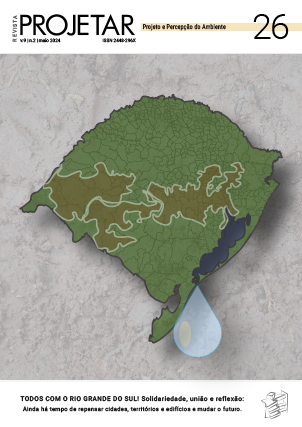RELAÇÃO PESSOA-AMBIENTE NO SISTEMA DE PREVENÇÃO COMMUNITIES THAT CARE
DOI:
https://doi.org/10.21680/2448-296X.2024v9n2ID34272Palabras clave:
psicologia ambiental, participação da comunidade, sistema de prevenção, communities that care, saúde comunitáriaResumen
Atentos aos benefícios a serem desfrutados por moradores ao imergir junto à comunidade, a Ciência da Prevenção possibilita a qualificação de ações comunitárias tendo o território como base interventiva. O Communities That Care (CTC) é um sistema de prevenção que vem se destacando como modelo internacional sobre intervenções multiníveis baseadas em evidência, como base em estudos dos determinantes sociais e ambientais. Objetivou-se estabelecer uma interlocução entre a Psicologia Ambiental e o referido sistema de prevenção, ao compreender a influência das vinculações de identidade e de apego ao lugar para adesão das lideranças comunitárias ao Communities That Care. O contexto da pesquisa envolveu um dos distritos de Florianópolis e todas suas particularidades. O percurso metodológico envolveu as técnicas de caminhada pelo local, vestígios ambientais e entrevistas semiestruturadas. Os dados colhidos foram apreciados à luz da Análise Temática e suscitaram a criação de duas categorias de análise, são elas: afeto e interações; lugar e pertença. Os principais resultados evidenciaram como pontos de inflexão na dinâmica relacional a percepção de relevância das práticas culturais, cuidado socioambiental, segurança e habitabilidade, identificação e afetividade para com a comunidade. A relação estabelecida com a comunidade, principalmente a identidade e o apego ao lugar, aos seus valores e engajamento em ações coletivas, potencializam a adesão ao Sistema de Prevenção Communities That Care e facilitam o planejamento de ações comunitária de âmbito preventivo ao uso de drogas e violências.
Descargas
Citas
AMIN, H. M. T. The impact of heritage decline on urban social life. Journal of Environmental Psychology, v. 55, p. 34-47, 2018. https://doi.org/10.1016/j.jenvp.2017.12.002
BELANCHE, D.; CASALÓ, L. V.; FLAVIÁN, C. Understanding the cognitive, affective and evaluative components of social urban identity: Determinants, measurement, and practical consequences. Journal of Environmental Psychology, v. 50, p. 138-153, 2017. https://doi.org/10.1016/j.jenvp.2017.02.004
BERNARDO, F.; PALMA-OLIVEIRA, J. M. Urban neighbourhoods and intergroup relations: The importance of place identity. Journal of Environmental Psychology, v. 45, p. 239-251, 2016. https://doi.org/10.1016/j.jenvp.2016.01.010
BIEDENWEG, K.; SCOTT, R. P.; SCOTT, T. A. How does engaging with nature relate to life satisfaction? Demonstrating the link between environment-specific social experiences and life satisfaction. Journal of Environmental Psychology, v. 50, p. 112-124, 2017. https://doi.org/10.1016/j.jenvp.2017.02.002
BOMFIM, Z. A. C.; DELABRIDA, Z. N. C.; FERREIRA, K. P. M. Emoções e afetividade ambiental. In: CAVALCANTE, S.; ELALI, G. A. Psicologia Ambiental: conceitos para leitura da relação pessoa-ambiente. Petrópolis, RJ, 2018, p. 60-74.
BRAUN, V.; CLARKE, V. Using thematic analysis in psychology. Qualitative research in psychology, v. 3, n. 2, p. 77-101, 2006. https://doi.org/10.1191/1478088706qp063oa
BRAUN, V.; CLARKE, V. Reflecting on reflexive thematic analysis. Qualitative research in sport, exercise and health, v. 11, n. 4, p. 589-597, 2019. https://doi.org/10.1080/2159676X.2019.1628806
CABASSA, L. J., PARCESEPE, A.; NICASIO, A.; BAXTER, E.; TSEMBERIS, S.; LEWIS-FERNÁNDEZ, R. Health and wellness photovoice project: Engaging consumers with serious mental illness in health care interventions. Qualitative health research, v. 23, n. 5, p. 618-630, 2013. https://doi.org/10.1177/1049732312470872
CASARIN, V.; SOETHE, B. K.; HENICKA, B. C. P.; FELIPPE, M. L. A resposta afetiva dos sujeitos às paisagens avistadas de suas janelas. Revista Projetar-Projeto e Percepção do Ambiente, v. 8, n. 2, p. 109-123, 2023.
EDWARDS, R. W.; JUMPER-THURMAN, P.; PLESTED, B. A.; OETTING, E. R.; SWANSON, L. Community readiness: Research to practice. Journal of community psychology, v. 28, n. 3, p. 291-307, 2000. https://doi.org/10.1002/(SICI)1520-6629(200005)28:3<291::AID-JCOP5>3.0.CO;2-9
FELIPPE, M. L.; KUHNEN, A.; SILVEIRA, B. B.; LELLI, G. What Is a Restorative Hospital Environment? Environmental Meaning, Affective Stress Restoration and Physical Attributes in Pediatric Inpatient Rooms. Children, Youth and Environments, v. 27, n. 1, p. 17-46, 2017. https://www.jstor.org/stable/10.7721/chilyoutenvi.27.1.0017
FRANCIS, J.; GILES-CORTI, B.; WOOD, L.; KNUIMAN, M. Creating sense of community: The role of public space. Journal of environmental psychology, v. 32, n. 4, p. 401-409, 2012. https://doi.org/10.1016/j.jenvp.2012.07.002
GATERSLEBEN, B.; WYLES, K. J.; MYERS, A.; OPITZ, B. Why are places so special? Uncovering how our brain reacts to meaningful places. Landscape and Urban Planning, v. 197, p. 103758, 2020. https://doi.org/10.1016/j.landurbplan.2020.103758
HAWKINS, J. D.; CATALANO, R. F.; ARTHUR, M. W.; EGAN, E.; BROWN, E. C.; ABBOTT, R. D.; MURRAY, D. M. Testing Communities That Care: The Rationale, Design and Behavioral Baseline Equivalence of the Community Youth Development Study. Prevention Science, v. 9, p. 178-190, 2008. https://doi.org/10.1007/s11121-008-0092-y
HIGUCHI, M. I. G.; KUHNEN, A.; BOMFIM, Z. A. C. Cognição Ambiental. In: CAVALCANTE, S.; ELALI, G. A.(Orgs.). Temas básicos em psicologia ambiental. Petrópolis, RJ: Vozes, 2011. p. 105-121.
KOURTIT, K.; NIJKAMP, P.; TÜRK, U.; WAHLSTROM, M. City love and place quality assessment of liveable and loveable neighbourhoods in Rotterdam. Land Use Policy, v. 119, p. 106109, 2022. https://doi.org/10.1016/j.landusepol.2022.106109
LENGEN, C.; TIMM, C.; KISTEMANN, T. Place identity, autobiographical memory and life path trajectories: The development of a place-time-identity model. Social Science & Medicine, v. 227, p. 21-37, 2019. https://doi.org/10.1016/j.socscimed.2018.09.039
LEWICKA, M. Place attachment: How far have we come in the last 40 years?. Journal of environmental psychology, v. 31, n. 3, p. 207-230, 2011. https://doi.org/10.1016/j.jenvp.2010.10.001
LIU, Q. et al. More meaningful, more restorative? Linking local landscape characteristics and place attachment to restorative perceptions of urban park visitors. Landscape and Urban Planning, v. 197, p. 103763, 2020. https://doi.org/10.1016/j.landurbplan.2020.103763
MANZO, L. C. Beyond house and haven: Toward a revisioning of emotional relationships with places. Journal of environmental psychology, v. 23, n. 1, p. 47-61, 2003. https://doi.org/10.1016/S0272-4944(02)00074-9
MOULAY, A.; UJANG, N.; MAULAN, S.; ISMAIL, S. Understanding the process of parks’ attachment: Interrelation between place attachment, behavioural tendencies, and the use of public place. City, Culture and Society, v. 14, p. 28-36, 2018. https://doi.org/10.1016/j.ccs.2017.12.002
MOURÃO, A. R. T.; CAVALCANTE, S. O processo de construção do lugar e da identidade dos moradores de uma cidade reinventada. Estudos de Psicologia (Natal), v. 11, p. 143-151, 2006. https://doi.org/10.1590/S1413-294X2006000200003
PEDROSO, R. T.; JUHÁSOVÁ, M. B.; HAMANN, E. M. Evidence-based science in public policies for reinventing alcohol and drugs use prevention. Interface-Comunicação, Saúde, Educação, v. 23, 2019. https://doi.org/10.1590/Interface.170566
PEI, Z. Roles of neighborhood ties, community attachment and local identity in residents’ household waste recycling intention. Journal of Cleaner Production, v. 241, p. 118217, 2019. https://doi.org/10.1016/j.jclepro.2019.118217
PIPPI, L. G. A.; LAUTERT, A. R. Praças como espaços públicos relevantes: conceitos pertinentes ao projeto. Revista Projetar-Projeto e Percepção do Ambiente, v. 4, n. 1, p. 112-124, 2019.
PONTE, A.Q; BOMFIM, Z. A. C.; PASCUAL, J. G. Considerações teóricas sobre identidade de lugar à luz da abordagem histórico-cultural. Psicologia Argumento, Curitiba, v.27, n.59, p. 345-354, out./dez. 2009.
QUINN, T.; BOUSQUET, F.; GUERBOIS, C. Changing places: The role of sense of place in perceptions of social, environmental and overdevelopment risks. Global Environmental Change, v. 57, p. 101930, 2019. https://doi.org/10.1016/j.gloenvcha.2019.101930
RAPOPORT, A. The meaning of the built environment: A nonverbal communication approach. University of Arizona Press, 1990.
SALES, L. P.; MICHELS, C. Entorno urbano imediato: um estudo de caso no condomínio residencial Cidadão Manauara 2. Revista Projetar-Projeto e Percepção do Ambiente, v. 8, n. 3, p. 90-104, 2023.
SASSEN, S.; CASTRO, L. G. R.; SANTORO, P. O que é espaço público? In: Revista aU. São Paulo: Editora PINI, ano 28, n. 232, jul. 2013. Disponível em http://au.pini.com.br/arquitetura-urbanismo/232/o-que-e-espaco-publico-292045-1.aspx. Acesso em 11 de outubro de 2023.
SCANNELL, L.; GIFFORD, R. Defining place attachment: A tripartite organizing framework. Journal of environmental psychology, v. 30, n. 1, p. 1-10, 2010. https://doi.org/10.1016/j.jenvp.2009.09.006
SCHNEIDER, D. R.; THUROW, C. F.; BROWN, E. C.; MURTA, S. G. (2021). Communities That Care (CTC): Community Prevention Interventions. In: Drugs and Human Behavior Biopsychosocial Aspects of Psychotropic Substances Use. Cham: Springer International Publishing, 2021. p. 371-380. https://doi.org/10.1007/978-3-030-62855-0_26
SLOBODA, Z.; PETRAS, H. Defining prevention science. New York, NY: Springer, 2014. https://doi.org/10.1007/978-1-4899-7424-2
STITH, S.; PRUITT, I.; DEES, J.; FRONCE, M.; GREEN, N.; SOM, A.; LINKH, D. Implementing community-based prevention programming: A review of the literature. Journal of Primary Prevention, v. 27, p. 599-617, 2006. https://doi.org/10.1007/s10935-006-0062-8
TUAN, Y.-F. Espaço e lugar: a perspectiva da experiência. São Paulo: Difel, 2013.
ULRICH, Roger S. Aesthetic and affective response to natural environment. In: Behavior and the natural environment. Boston, MA: Springer US, 1983. p. 85-125.
Descargas
Publicado
Cómo citar
Número
Sección
Licencia
Derechos de autor 2024 Bettieli Barboza da Silveira, Daniela Ribeiro Schneider

Esta obra está bajo una licencia internacional Creative Commons Atribución-NoComercial-CompartirIgual 4.0.
Autores que publicam nesta revista concordam com os seguintes termos:
- Autores mantém os direitos autorais e concedem à revista o direito de primeira publicação, sendo o trabalho licenciado sob a licença Creative Commons Atribuição-NãoComercial-CompartilhaIgual segundo a qual é permitido o compartilhamento do trabalho com reconhecimento da autoria e publicação inicial nesta revista.
- Autores têm autorização para assumir, separadamente, contratos adicionais para distribuição não-exclusiva da versão do trabalho publicada nesta revista (ex.: publicar em repositório institucional ou como capítulo de livro), desde que com reconhecimento de autoria e publicação inicial nesta revista.
- Autores têm permissão e são estimulados a publicar e distribuir seu trabalho online (ex.: em repositórios institucionais ou na sua página pessoal) desde que concluído o processo editorial, já que isso pode gerar alterações produtivas, bem como aumentar o impacto e a citação do trabalho publicado (Veja O Efeito do Acesso Livre).
- Não recomenda-se publicação e distribuição do artigo antes de sua publicação, pois isso poderá interferir na sua avaliação cega pelos pares.








